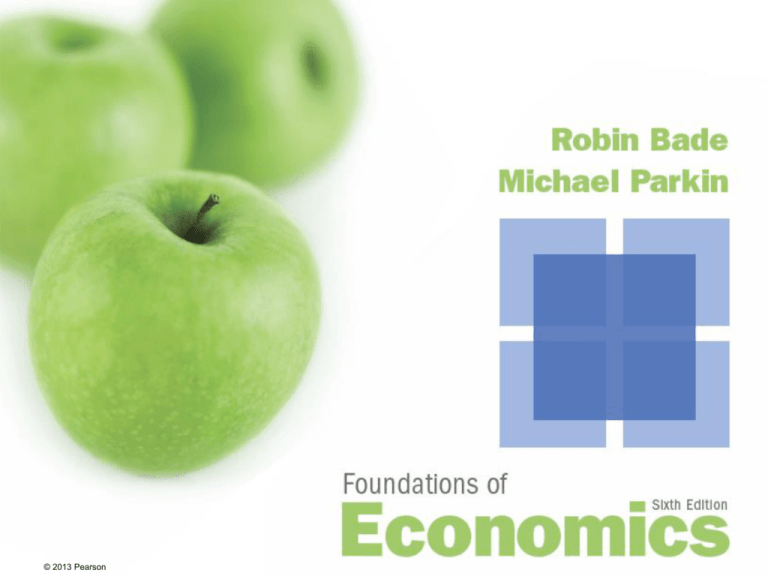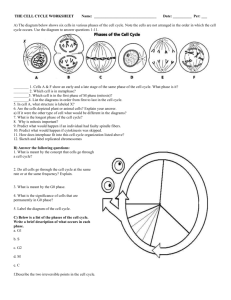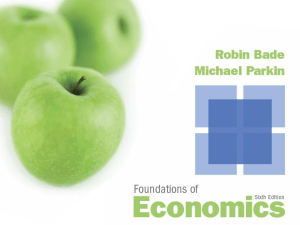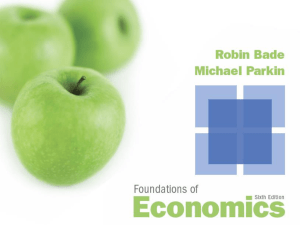Chapter 7 Checkpoint
advertisement

Click on the button to go to the problem © 2013 Pearson Government Actions in Markets 7 CHECKPOINTS © 2013 Pearson Click on the button to go to the problem Checkpoint 7.1 Checkpoint 7.2 Checkpoint 7.3 Problem 1 Problem 1 Problem 1 Problem 2 Problem 2 Problem 2 Problem 3 In the News © 2013 Pearson Clicker version Problem 3 Problem 4 Clicker version Problem 3 Problem 4 Clicker version CHECKPOINT 7.1 Practice Problem 1 The figure shows the rental market for apartments in Corsicana, Texas. What is the rent in this city and how many apartments are rented? If the city government imposes a rent ceiling of $900 a month, what is the rent, and how many apartments are rented? © 2013 Pearson CHECKPOINT 7.1 Solution A rent ceiling of $900 a month is above the equilibrium rent, so the outcome is the market equilibrium rent of $800 a month with 3,000 apartments rented. © 2013 Pearson CHECKPOINT 7.1 Practice Problem 2 The figure shows the rental market for apartments in Corsicana, Texas. If the city government imposes a rent ceiling of $600 a month, what is the rent, and how many apartments are rented? If a black market develops, how high could the black market rent be? Explain your answer. © 2013 Pearson CHECKPOINT 7.1 Solution With the rent ceiling at $600 a month, the number of apartments rented is 1,000 and the rent is $600 a month. In a black market, some people are willing to rent an apartment for more than the rent ceiling. © 2013 Pearson CHECKPOINT 7.1 The highest rent that someone would offer is $1200 a month. This rent equals someone’s willingness to pay for the 1,000th apartment. © 2013 Pearson CHECKPOINT 7.1 Practice Problem 3 The figure shows the rental market for apartments in Corsicana, Texas. With a strictly enforced rent ceiling of $600 a month, is the housing market efficient? What is the deadweight loss? Is the housing market fair? Explain why or why not. © 2013 Pearson CHECKPOINT 7.1 Solution The housing market is not efficient. With 1,000 apartments rented, marginal benefit exceeds marginal cost and a deadweight loss arises. © 2013 Pearson CHECKPOINT 7.1 The deadweight loss equals the area of the gray triangle: Deadweight loss equals ½ of (1,200 – 600) x (3,000 – 1,000). Deadweight loss is $600,000. © 2013 Pearson CHECKPOINT 7.1 The rent ceiling makes the allocation of housing less fair in both views of fairness: 1. It blocks voluntary transactions, 2. It does not provide more housing to those in most need. © 2013 Pearson CHECKPOINT 7.1 Study Plan Problem With a strictly enforced rent ceiling of $600 a month, the housing market is _______. A. efficient because a rent ceiling gives poorer people greater access to housing B. efficient because the marginal cost of the last apartment rented is greater than its marginal benefit C. inefficient because the marginal cost of the last apartment rented is greater than its marginal benefit D. inefficient because the marginal benefit from the last apartment rented is greater than its marginal cost. © 2013 Pearson The figure shows the rental market for apartments. CHECKPOINT 7.1 In the News Rising oil prices worry U.S. finance chiefs Tupperware’s CFO says rising oil prices would cause the company to pay $15 million more for resin, which is based on oil, than it did a year ago. Resin prices are closely tied to the price of oil, which peaked at $114 a barrel in April. Source: The Wall Street Journal, April 27, 2011 If the government puts a price cap on resin at today’s price ($100 a barrel), explain why a shortage will occur. Which allocation method is mostly likely to be used to distribute resin? © 2013 Pearson CHECKPOINT 7.1 Solution Resin is made from oil, so a rise in the price of oil increases the cost of making resin and decreases the supply of resin. The equilibrium price of resin will rise. A price cap at $100 a barrel will create a shortage because the price cap is below the market equilibrium price. Resin will be allocated by the first-come, first-served method unless the government rations resin, in which case it will be allocated by command. © 2013 Pearson CHECKPOINT 7.2 Practice Problem 1 The figure shows the market for tomato pickers in southern California. What is the equilibrium wage rate and what is the equilibrium quantity of tomato pickers employed? If California introduces a minimum wage of $4 an hour, how many tomato pickers are employed, and how many are unemployed? © 2013 Pearson CHECKPOINT 7.2 Solution The equilibrium wage rate is $6 an hour, and 4,000 pickers are employed. The minimum wage of $4 an hour is below the equilibrium wage rate, so 4,000 tomato pickers are employed and none are unemployed. © 2013 Pearson CHECKPOINT 7.2 Practice Problem 2 The figure shows the market for tomato pickers in southern California. If California introduces a minimum wage of $8 an hour, how many tomato pickers are employed and how many are unemployed? What is the lowest wage that some workers might be able to earn if a black market developed? © 2013 Pearson CHECKPOINT 7.2 Solution The minimum wage of $8 an hour is above the equilibrium wage rate: 3,000 pickers are employed (from the demand curve) 5,000 people would like to work as pickers for $8 an hour (from the supply curve), 2,000 pickers are unemployed. © 2013 Pearson CHECKPOINT 7.2 If a black market developed, the lowest wage that some workers might be able to earn would be $4 an hour. © 2013 Pearson CHECKPOINT 7.2 Practice Problem 3 The figure shows the market for tomato pickers in southern California. Is the minimum wage of $8 an hour efficient? Who gains and who loses from the minimum wage of $8 and hour? Is the minimum wage of $8 an hour fair? © 2013 Pearson CHECKPOINT 7.2 Solution The minimum wage of $8 an hour is not efficient because the marginal benefit to growers (on the demand curve) exceeds the marginal cost to pickers (on the supply curve). The minimum wage creates a deadweight loss. An additional loss arises as unemployed pickers search for jobs. © 2013 Pearson CHECKPOINT 7.2 The tomato pickers who find work at $8 an hour gain. The tomato growers and the unemployed pickers lose. The minimum wage is unfair on both the fair rules and fair results views of fairness. © 2013 Pearson CHECKPOINT 7.2 Study Plan Problem The figure shows the market for tomato pickers in southern California. If California introduces a minimum wage of $8.00 an hour, the minimum wage is __________. A. inefficient and not fair B. efficient and fair only if the workers can increase the number of hours they work C. inefficient but fair D. efficient and fair E. efficient but not fair © 2013 Pearson CHECKPOINT 7.2 The figure shows the market for tomato pickers in southern California. If California introduces a minimum wage of $8.00 an hour, ________gain and_______ lose. A. unemployed pickers and tomato growers; employed pickers B. unemployed pickers; tomato growers C. tomato growers; tomato growers who find work D. employed pickers; tomato growers and unemployed pickers E. all pickers; tomato growers © 2013 Pearson CHECKPOINT 7.2 In the News Hong Kong introduces a minimum wage Hong Kong’s first minimum wage is set at $HK28 an hour—$HK5 less than labor unions wanted, but $HK5 more than the employers had offered. About 315,000 people will be affected by the new wage.. Source: The Economist, January 11, 2011 What will be the effects of the minimum wage if the employers’ offer is equal to the equilibrium wage? What will be the effects of the minimum wage if the labor unions’ demand is equal to the equilibrium wage? © 2013 Pearson CHECKPOINT 7.2 Solution If the employers’ offer of $HK23 an hour is the equilibrium wage rate, then the minimum wage exceeds the equilibrium wage and some of the 315,000 workers will become unemployed. If the union’s demand of $HK33 an hour is the equilibrium wage rate, then the minimum wage is below the equilibrium wage and the minimum wage has no effect on the quantity of labor employed. © 2013 Pearson CHECKPOINT 7.3 Practice Problem 1 The figure shows the market for tomatoes. What are the equilibrium price and quantity of tomatoes? Is the market for tomatoes efficient? © 2013 Pearson CHECKPOINT 7.3 Solution The equilibrium price is $6 per pound, and the equilibrium quantity is 2 billion pounds a year. The market for tomatoes is efficient—marginal benefit equals marginal cost and total surplus is maximized. © 2013 Pearson CHECKPOINT 7.3 Practice Problem 2 The figure shows the market for tomatoes. The government introduces a price support for tomatoes at $8 per pound. What is the quantity of tomatoes produced, the quantity demanded, and the subsidy received by tomato farmers? © 2013 Pearson CHECKPOINT 7.3 Solution At a support price of $8 per pound, 3 billion pounds are produced and 1 billion pounds are demanded, so there is a surplus of 2 billion pounds. The subsidy is $8 per pound on 2 billion pounds, which is $16 billion. © 2013 Pearson CHECKPOINT 7.3 Practice Problem 3 The figure shows the market for tomatoes. With the price support at $8 per pound, is the market for tomatoes efficient? Who gains and who loses from the price support? What is the deadweight loss? Could the price support be regarded as being fair? © 2013 Pearson CHECKPOINT 7.3 Solution The market is not efficient because at the quantity produced, the marginal benefit (on the demand curve) is less than the marginal cost (on the supply curve). © 2013 Pearson CHECKPOINT 7.3 Farmers gain. Farmers produce more and receive a higher price on what they sell in the market, and they receive the government subsidy. Consumers/taxpayers lose. They pay more for tomatoes and pay taxes to fund the subsidy. The deadweight loss is $2 billion (the area of the gray triangle). © 2013 Pearson CHECKPOINT 7.3 The outcome is unfair on both views of fairness unless farmers are poorer than the consumers, in which case it might be fair to boost farmers’ incomes. © 2013 Pearson CHECKPOINT 7.3 Study Plan Problem The figure shows the market for tomatoes. With the price support at $8 per pound, the quantity produced is ____ because _____ . A. inefficient; marginal cost is less than marginal benefit B. efficient; marginal cost equals marginal benefit C. inefficient; marginal benefit is less than marginal cost D. efficient; marginal benefit is less than marginal cost © 2013 Pearson CHECKPOINT 7.3 The figure shows the market for tomatoes. The government introduces a price support for tomatoes at $8 per pound. With the price support, _____ lose and ______ gain. A. farmers; consumers and taxpayers B. consumers and taxpayers; farmers and the government C. taxpayers; farmers and consumers D. consumers and taxpayers; farmers © 2013 Pearson CHECKPOINT 7.3 In the News French farmers man the blockades in Brussels Farmers want the dairy industry to guarantee a minimum milk price of 300 euros a ton—against 210 euros a ton this month. Max Bottier, a dairy farmer in Normandy, said that he needs 300 euros a ton to break even. Source: The Times, May 26, 2009 If a support price for milk set at 300 euros a ton, how will the quantity of milk produced and the quantity bought by consumers change? Who buys the surplus? Will the milk market be more or less efficient than it is today? © 2013 Pearson CHECKPOINT 7.3 Solution The market price today is 210 euros a ton. A support price of 300 euros a ton will increase the quantity of milk supplied and decrease the quantity of milk demanded. There will be a surplus of milk. To maintain the support price at 300 euros a ton, the government will have to buy the surplus of milk at the support price. The market will be less efficient because it creates a deadweight loss. © 2013 Pearson








